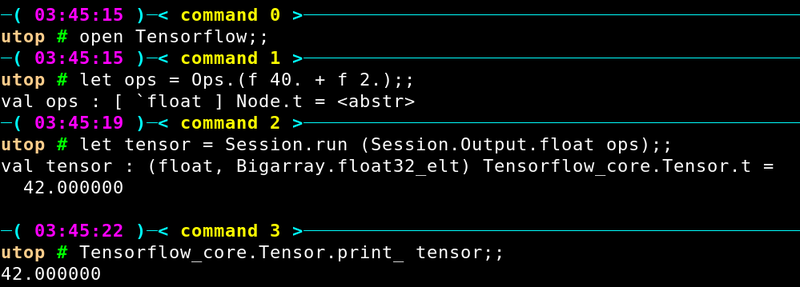The tensorflow-ocaml project provides some OCaml bindings for TensorFlow.
Experimental ocaml bindings for PyTorch can be found in the ocaml-torch repo.
Use opam to install the tensorflow-ocaml package. Starting from version 0.0.11 this will automatically install the TensorFlow library.
opam install tensorflowTo build your first TensorFlow program, create a new directory and cd into it.
Then create a forty_two.ml file with the following content:
open Tensorflow
let () =
let forty_two = Ops.(f 40. + f 2.) in
let v = Session.run (Session.Output.scalar_float forty_two) in
Printf.printf "%f\n%!" vThen create a dune file with the following content:
(executables
(names forty_two)
(libraries tensorflow))Run dune build forty_two.exe to compile the program and
_build/default/forty_two.exe to run it!
You can also use Tensorflow via utop.
The TensorFlow library installed via opam does not support GPU acceleration.
In order to use your GPU you will have to install TensorFlow 1.14, either
by building it from source or by using prebuilt binaries. Then
the library should be installed system-wide or you could set the
LIBTENSORFLOW environment variable.
export LIBTENSORFLOW={path_to_folder_with_libtensorflow.so}Possible ways to get the TensorFlow library:
-
Use prebuilt binaries from Google. The releases are available for download in URLs of the form:
https://storage.googleapis.com/tensorflow/libtensorflow/libtensorflow-TYPE-OS-ARCH-VERSION.tar.gz. For example: -
Build the library from source. Perform the following steps:
-
Install the Bazel build system.
-
Clone the TensorFlow repo:
git clone --recurse-submodules -b r1.14 https://github.com/tensorflow/tensorflow -
Configure the build (you will be asked if you want to enable CUDA support):
cd tensorflow/ ./configure -
Compile the library:
bazel build -c opt tensorflow:libtensorflow.soThe binary should appear under
bazel-bin/tensorflow/libtensorflow.so.
-
Tensorflow-ocaml includes two different APIs to write graphs.
The graph API is very close to the original TensorFlow API.
-
Some MNIST based tutorials are available in the examples directory. A simple Convolutional Neural Network can be defined as follows:
let ys_ = O.Placeholder.to_node xs |> Layer.reshape ~shape:[ -1; 28; 28; 1 ] |> Layer.conv2d ~ksize:(5, 5) ~strides:(1, 1) ~output_dim:32 |> Layer.max_pool ~ksize:(2, 2) ~strides:(2, 2) |> Layer.conv2d ~ksize:(5, 5) ~strides:(1, 1) ~output_dim:64 |> Layer.max_pool ~ksize:(2, 2) ~strides:(2, 2) |> Layer.flatten |> Layer.linear ~output_dim:1024 ~activation:Relu |> O.dropout ~keep_prob:(O.Placeholder.to_node keep_prob) |> Layer.linear ~output_dim:10 ~activation:Softmax in
-
examples/load/load.mlcontains a simple example where the TensorFlow graph is loaded from a file (this graph has been generated byexamples/load.py), -
examples/basicscontains some curve fitting examples. You will need gnuplot to be installed via opam to run the gnuplot versions.
The FNN API is a layer based API to easily build neural-networks. A linear classifier could be defined and trained in a couple lines:
let input, input_id = Fnn.input ~shape:(D1 image_dim) in
let model =
Fnn.dense label_count input
|> Fnn.softmax
|> Fnn.Model.create Float
in
Fnn.Model.fit model
~loss:(Fnn.Loss.cross_entropy `mean)
~optimizer:(Fnn.Optimizer.gradient_descent ~learning_rate:8.)
~epochs
~input_id
~xs:train_images
~ys:train_labels;A complete VGG-19 model can be defined as follows:
let vgg19 () =
let block iter ~block_idx ~out_channels x =
List.init iter ~f:Fn.id
|> List.fold ~init:x ~f:(fun acc idx ->
Fnn.conv2d () acc
~name:(sprintf "conv%d_%d" block_idx (idx+1))
~w_init:(`normal 0.1) ~filter:(3, 3) ~strides:(1, 1) ~padding:`same ~out_channels
|> Fnn.relu)
|> Fnn.max_pool ~filter:(2, 2) ~strides:(2, 2) ~padding:`same
in
let input, input_id = Fnn.input ~shape:(D3 (img_size, img_size, 3)) in
let model =
Fnn.reshape input ~shape:(D3 (img_size, img_size, 3))
|> block 2 ~block_idx:1 ~out_channels:64
|> block 2 ~block_idx:2 ~out_channels:128
|> block 4 ~block_idx:3 ~out_channels:256
|> block 4 ~block_idx:4 ~out_channels:512
|> block 4 ~block_idx:5 ~out_channels:512
|> Fnn.flatten
|> Fnn.dense ~name:"fc6" ~w_init:(`normal 0.1) 4096
|> Fnn.relu
|> Fnn.dense ~name:"fc7" ~w_init:(`normal 0.1) 4096
|> Fnn.relu
|> Fnn.dense ~name:"fc8" ~w_init:(`normal 0.1) 1000
|> Fnn.softmax
|> Fnn.Model.create Float
in
input_id, modelThis model is used in the following example to classify an input image. In order to use it you will have to download the pre-trained weights.
There are also some MNIST based examples.
The examples directory contains various models among which:
- A simplified version of char-rnn illustrating character level language modeling using Recurrent Neural Networks.
- Neural Style Transfer applies the style of an image to the content of another image. This uses some deep Convolutional Neural Network.
- Some variants of Generative Adversarial Networks. These are used to generate MNIST like images.
- dune is used as a build system.
- ocaml-ctypes is used for the C bindings.
- Base is only necessary when generating the TensorFlow graph from OCaml, the wrapper itself does not need it.
- The code in the piqi directory comes from the Piqi project. There is no need to install piqi though.
- Cmdliner is used for command line interfaces.
- Gnuplot-ocaml is an optional dependency used by a couple examples.
- npy-ocaml is used to read/write from npy/npz files.
